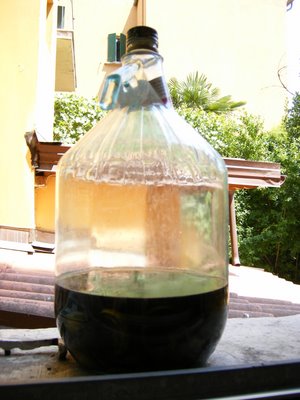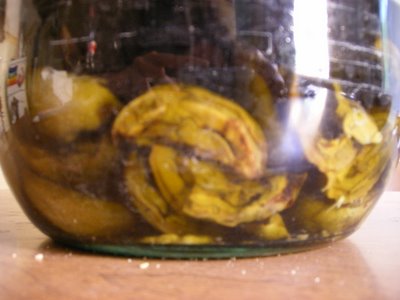green walnuts

I'm struggling to describe the scent of green walnuts. Resinous. Woody. Astringent. Hints of musk, something like the smell of a pile of raked leaves in early autumn, not dried leaves but the smell of green still in them.
Green walnuts to make nocino. I found them at my fruttivendolo after a few anxious days past the appointed June 24, the feast day of San Giovanni Battista. On that pagan midsummer's celebration cum Catholic holiday, tradition holds that the walnuts be gathered before the dew has evaporated. I'd had an eye out for walnut trees to no avail. But the matriarch of the delightfully weird family that runs my favorite fruit and vegetable store had set aside a basket from their family's tree. I recognized them, to her astonishment, and bought a few euros worth. The signora and I have what is known in Italian as "un feeling" -- if I stop by when she's not busy she will advise me on recipes and fill up bags of the last yellow cherries of the season, discounted; I tell her what I'm making for dinner, ask advice about which tomatoes to buy. The "feeling" doesn't extend so far, though, that the best tomatoes aren't also the most expensive....
 Once home, I wiped the noci (walnuts) clean and set to quartering them. This was a task for my kitchen machete, a rusting antique I found in a bottom drawer that does double duty as my garden machete for mowing the lawn and pruning -- to my friends' and neighbors' amusement and horror.
Once home, I wiped the noci (walnuts) clean and set to quartering them. This was a task for my kitchen machete, a rusting antique I found in a bottom drawer that does double duty as my garden machete for mowing the lawn and pruning -- to my friends' and neighbors' amusement and horror.A swift smack of the machete cleanly halved the noci, and another produced pieces small enough to fit into the neck of a demijohn. The tannins left greenish brown stains on my hands and chopping board, and immediately turned the pure alcohol I used to cover the noci pieces to a swampy color.
A side note: I was confident from the color and astringent smell that I was dealing with tannins, but checked my instincts with Dr. Duke's phytochemical and ethnobotanical database. As the title suggests, it contains exhaustive information about plants' chemical components -- for example, how much strontium is in walnut husks? -- as well as reported uses of these chemicals and plants. I use it for my amateur botany interests. Anyone with enough of a science background to know what counts as a heavy metal, to know that ascorbic acid is vitamin C, or enough curiosity to wonder, "Am I getting enough molybdenum in my diet?" might find it interesting. It takes great restraint here not to begin ranting about ignorance, I'll save my "anti-oxidants are just the same vitamins and minerals in the same goddamned fruits and vegetables you always knew you were supposed to eat, dumbass! Go choke on some broccoli!" abuses for another post.

The noci get enhanced by a little cinnamon, lemon zest, and cloves and sit until the end of the summer. Then I'll add sugar and water, filter out the noci, and bottle the liqueur. It will still need to mature for three months, at which point it will be chilly enough for the strong, bitter liqueur to be particularly welcome before bedtime.
There is something satisfying in the waiting, thinking ahead to winter evenings, pleasures deferred. I'm bottling up a part of the summer. In with the green walnuts and spices go a memory of this June, who I am now. All of the meanings of serving thimble glasses of nocino to guests, the presentation of "I made this with this moment in mind" are intensely personal and social. I'm acting out an ancient ritual. So if any friends or hellenic gods in disguise stop by this November, I'll be prepared.


0 Comments:
Post a Comment
<< Home